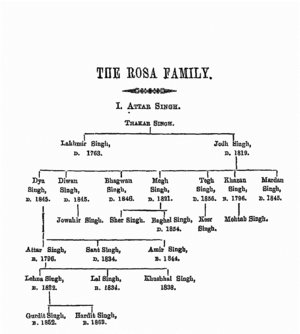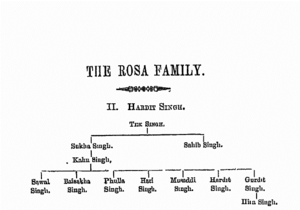Rose
Rose (रोसे)[1] Rosa (रोसा) gotra Jats found in Rajasthan, Punjab and Haryana. Rosyah/Rosya/Rozi is clan of the Agnikula Chohans. [2]
Contents
Origin
They get name after their ancestor named Rosa.
Villages founded by Rosa clan
- Thethalia (थेथलिया) - village in Fatehpur tehsil in Sikar district in Rajasthan. It was founded by Rosa Jats who later called themselves as Barjati.
In Mahabharata
Karna Parva/Mahabharata Book VIII Chapter 44 mentions word Rosha. [3]
History
Roseshwar dham (रोसेश्वर धाम) is the famous place near Rajpur in Barwani, Madhya Pradesh. It is situated on a hill called Roseshwar hill located 5km from Rajpur. Here two temples are also present. One is Shiva temple, other is navgrah temple.
Hukum Singh Panwar (Pauria)[4] writes that: Here we refer again to Varahamihira who gives somatometric traits or anthropometrical description of five great men Hansa, Sasa, Rucaka, Bhadra and Malavya to serve as specimen.
Varahamihira divides human beings (Indians) into five standardised types to guide sculptors and gives details of their physical features for the benefit of those practising the art of sculpture in fine arts181. The names of the five men chosen by Varahamihira point to their respective
The Jats:Their Origin, Antiquity and Migrations: End of p.144
homonymous tribes, which are described by the classical writers and the Epics. The physionomical details of the five great men are given below.
Hukum Singh Panwar (Pauria)[5] writes that:
Sasa, (Sese, Sse, Saso, Sasaka, Sakas), slightly projecting and thin teeth, thin nails, large eyeballs, fleshy cheek, too much narrow and slender waist, not very stout, age 70 years and is said to be a border-chief (Pratyantika) or vassal (Mandalika) with height, span and girth of 99 angulas or 72.9 inches each.
During first century A.D., Aspavarman, son of Vijayamitra and grandson of Indravardhan is said to have been the Viceroy of Azes II in a district of north-western India but later served under Gondopharnes, followed by his nephew Sasa, who later served Pacores successor of Gandopharnes190. Most probably the Sasa family Was from Indo-Parthian who were undoubtedly a section of the Scythians, who were also known as Sasa, Sese, Sse, Sasak or Sakas in history. Even row the Jats call the north-western frontier people as Sasse and Khakkhai (Afghans and Pathans). Prof. E.J. Rapson191 refers to a number of Sasa Strategoi (senapatis), the suffixes like 'Varman' and 'Daua 'in whose names show that they were Hinduised Saka chiefs under the Parthian rulers of N.W. India. Interestingly, there are Shak, Sakwan, Saklan, Sheshwan, Madra-Maderna, Mall, Malli and Hans gotras (tribes) in the Jats as well as Ros or Rosai (Rucak) in them. The Sasas may be later Sasodias.
Rucaka188 :- "Height, span and girth 102 angulas or 75.6 inches each; reddish dark complexion, beautiful brows and hair, conch like neck, oblong face, rich blood and flesh, lean knees and shanks, weight 1000 palas (or 160 lbs.), Lord of the Vindhyas, Sahyagiri and Ujjayini, 70 years age".
Rosa family in Punjab Chiefs by Griffin
Sir Lepel Griffin[6] (1865):The Panjab Chiefs gives us the History of Rosa clan.It tells us that there is a tradition that, Rosa, A Sidhu Jat and an ancestor of this family migrated from Delhi some hundred years ago and founded a village Rosa in his name near Chunian (Present Rosa tibba no1) in Lahore.
In the first Rosa branch represented by Attar Singh, Thakar Singh Rosa was a risaldar in the service of famous Dina Beg Khan, Governor first of Jalandhar Doab and then of Punjab. On the death of his master, in 1758, he set up for him self, and contrived to possess himself a large tract of country in the Gogaira (Gogera:Okara District) and Gujranwala districts in Pakistan.
In 1765 he joined Hari Singh Bhangi and Jai Singh Kanhaiya in their expedition against Kasur where he was killed.
His successor was Jodh Singh, who went to Gujranwala. There Sardar Charrat Singh made him Thanedar. He built the old village of Rosa in the Chunian paragana and founded a second Rosa village in Sheikhapura.
Jodh Singh served Ranjit Singh of Lahore in the Kasur, Pindi Bhattian and Jhang campaigns, in the last of which he got jagir of Mohal and Draj in Jhang district as an award for his bravery. He was killed in 1819 at Rajori in second Kashmir expedition.
In 1832 Attar Singh Rosa was made adjudant in the Dhankal Singh Brigade and afterwards in the Sher Singhwala on its return from Kashmir. Attar Singh accompanied Sardar Ajit Singh Sindhanwalia to Kulu in in Dasowala Dera under Bahadur Singh, and remained there through all the Lahore revolutions, in which his general Ajit Singh perished. The Satlaj campaign was fatal to the family of Rosa, for, in one day, at Firushahar Dya Singh, Diwan Singh and Mardan Singh, were killed. Attar Singh was placed under the orders of Sardar Chattar Singh Attariwala, when that chief was sent as Governor to Hazara, and he joined him in rebellion in 1848.
The village of Rosa in the Sheikhupura pargana was held by the family according to the ancestral shares when Griffin wrote this book. The holders then were Jawahar Singh, Mehtab Singh, Attar Singh, Kesr Singh and Sher Singh.
The family tree is as under: Thakar Singh → Jodh Singh (d.1819) → Dya Singh (d. 1845) → Attar Singh (b. 1796) → Lehna Singh (b. 1882) → Gurdat Singh (b.1852) + Hardat Singh (b.1862)
In the second Rosa branch represented by Hardatt Singh was Tek Singh in the service of Bhangi Sardars of Lahore from whom he received grant of a deserted village Nodhpur. In 1794 when Nizamudin Khan drove Sikhs out of Kasur, Sukha Singh became officer under him and was killed in 1806 in battle. Sahib Singh his brother, was killed about the same time in a fight with zamindars of Bablair.
In 1822 Mousieur Allard joined services of Maharaja in Punjab under whom Kahn Singh Rosa was appointed Zamadar and next year promoted to Risaldar in same regiment in which he remained for seven years. He did so good service on frontier, that on the recommendation of General Ventura, he was appointed commandant in Khas Paltan and awarded the Jagir of Bilandi. He served in his regiment in Kulu, Mandi etc. Maharaja Sher Singh raised his cash allowance and gave additional Jagir of the village of Jodhpur and some wells in Rampur. Kahn Singh was severely wounded in attack on Raja Suchet Singh in March 1844.
When mutiny broke out in 1857 Kahn Singh was one of the first chiefs selected by the Chief Commissioner for service before Delhi. In a sally of the enemy he received a severe wound in the shoulder and he never fully recovered from its effect. It was with whole heart that Kahn Singh served in 1857. When disabled by his actual fighting he employed himself in procuring information, and on winning over to the side of English such of his country men as were in the ranks of the enemy, and more than forty of them he induced to desert.
In 1858, the Government conferred on him his old village of Balandi along with Todapur for his life and to descend for one generation and the estate of Maloki-Prem for perpetuity. He also received grant of confiscated house of Mahbub Ali Khan at Delhi. Kahn Singh died in June 1864, leaving two sons Hardutt Singh and Gurdatt Singh.
The third Rosa branch is represented by Tegh Singh Rosa. Tegh Singh son of Karam Singh was Risaldar for four years in North Western Provinces Military Police. He did admirable services in mutiny. He was severely wounded in April 1859 in fight with the rebels in Mirzapur jungles. He received his discharge in 1861 when new Police system waqs introduced. He was a distinguished gallantry and first rate officer respected and obeyed by his men. He is very distantly connected with the Rosa branches represented by Hardutt Singh and Attar Singh.
Complete history is available here at - http://www.apnaorg.com/books/punjab-chiefs/ on S.No. 56-58.
Rosas in Rajasthan
The oral tradition of Barjati clan tells us that In Rajasthan the Rosa (रोसा) clan of Jats came from Panipat in Haryana and founded the village Rosawa (रोसावा), located in west direction at a distance of about 15 km from Fatehpur in Sikar. Their population, in this village was not increasing but going down. So they changed their gotra (clan) to Barjati and moved to nearby village Thethalia in Sikar district. Thetahlia is considered to be origin of Barjatis and they spread from this village to various villages like Khuri, Kharia, Rooplisar in Churu district and Sardarpura in Sikar district in Rajasthan.
Distribution in Punjab
Villages in Gurdaspur district
Rose named village is in Gurdaspur tahsil of Gurdaspur district in Punjab, India.
Distribution in Rajasthan
Rose Jats are found in Nagaur and Jaipur districts.
Villages in Nagaur district
Locations in Jaipur city
Chitrakoot Jaipur, Jamuna Puri Murlipura Scheme,
Villages in Jaipur district
Villages in Alwar district
Distribution in Haryana
Villages in Sirsa District
Bharokhan village near district Sirsa of haryana have a good population of Rose (रोज) clan.
Notable persons
- Ramesh Rose - Date of Birth : 0-0-1953. Designation : Branch Manager, Department : Thar Aanchlik Gramin Bank. VPO - Chhajoli, Teh- Jayal, Nagaur,Raj. Present Address : Jat Colony, Bhaktasagar, Nagaur. Resident Phone Number : 02982221212, Mobile Number : 9413518500
- Dr. A. L. Choudhary (Rose) - President (Vet. Council of India) Animal Husbandry Deptt, Date of Birth : 7-June-1933. Permanent Address : B-2/492, Chitrakoot, Jaipur, Present Address : B-2/492, Chitrakoot, Jaipur. Resident Phone Number : Mobile Number : 9868866524
- C. L. Rose - Director School Education, Home District : Jaipur, Date of Birth :1963,Permanent Address : Jamuna Puri, Murlipura Scheme Jaipur -13 , Present Address : Rose Public s.r. Sec. School Jamuna Puri,Murlipura, Phone: 0141-2331276 , Mob: 9414043478
- P .C. Jat (Rose) - Sr. Manager Allahabad Bank, Date of Birth : 11-September-1959, Village: Kishanpura Chomu, Teh Chomu, Jaipur B-8 Jamunapuri, opp Rose public school, Murlipura, Jaipur, Present Address : B-8 Jamunapuri, opp Rose public school, Murlipura, Jaipur, Phone Number : 0141-2420511, Mob: 9414733877
- Ved Pal Rose, Chief Manager, Indian Farmers Fertiliser Cooperative Limited (IFFCO), New Delhi, India. e-mail vedpalrose@gmail.com, Founder: NITIN ROSE FOUNDATION
- Attar Singh Rosa - Rosa (Sindhu) - Jat, See-Rosa family in Punjab Chiefs by Griffin (1865), pp.342-348
- Gurdit Singh Rosa - Rosa (Sindhu) - Jat, See-Rosa family in Punjab Chiefs by Griffin (1865), pp.342-348
- Tegh Singh Rosa - Rosa (Sindhu) - Jat, See-Rosa family in Punjab Chiefs by Griffin (1865), pp.342-348
External links
References
- ↑ B S Dahiya:Jats the Ancient Rulers (A clan study), p.242, s.n.195
- ↑ An Inquiry Into the Ethnography of Afghanistan By H. W. Bellew, The Oriental University Institute, Woking, 1891, p.16,109,120
- ↑ परतिरब्धस ततः कर्णॊ रॊषात परस्फुरिताधरः | शिखण्डिनं तरिभिर बाणैर भरुवॊर मध्ये वयताडयत (Mahabharata:VIII.44.17)
- ↑ The Jats:Their Origin, Antiquity and Migrations/An Historico-Somatometrical study bearing on the origin of the Jats, p.144
- ↑ The Jats:Their Origin, Antiquity and Migrations/An Historico-Somatometrical study bearing on the origin of the Jats, p.146
- ↑ Rosa family in Punjab Chiefs by Griffin (1865), pp.342-348]
Back to Jat Gotras

